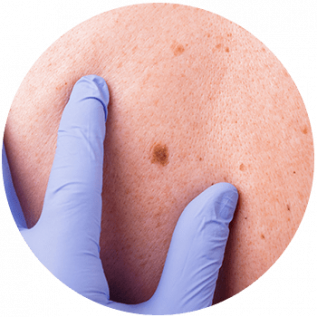
There’s no way around it— cancer is scary. Sometimes it might be tempting to skip the check up or ignore the potential signs that you might have an issue, because it seems easier than dealing with the problem head on. That said, with any type of cancer, early detection is paramount to increasing the chance of total healing and recovery. When it comes to skin cancer detection, there are some things to be aware of and on the lookout for, to ensure you are staying as healthy as possible.
Skin cancer, or the abnormal growth of skin cells, most commonly develops on areas of skin most often exposed to the sun. That means you can greatly decrease your risk of developing skin cancer by limiting sun exposure, wearing sunscreen whenever appropriate, and making sure you obtain regular dermatological check ups so any suspicious spots can be addressed early. Staying on top of these things can literally be a matter of life and death.
There are three major types of skin cancer including basal cell carcinoma, squamous cell carcinoma, and melanoma. Though it’s true that these abnormal cells generally form on areas that get the most sun exposure, skin cancer can also form in other areas such as your palms, underneath your nails, and even in the genital area. This is yet another reason those yearly dermatology screenings are so important.
Basal Cell Carcinoma
Basal cell carcinoma is one of the three categories of skin cancer, and it generally occurs on areas of the body most frequently exposed to the sun’s UV rays– like the neck or face.
Basal cell carcinoma can show up as:
-A flat, brown or flesh-colored lesion that looks almost scar-like
-A pearly or waxy-looking bump
-A bleeding or scabbing sore that seems to heal, then reappears
Squamous Cell Carcinoma
This skin cancer type also usually appears on sun-exposed areas of the skin, like the face, hands, or ears. That said, people with darker skin tones are more likely to develop this type in areas that do not get much sun exposure.
Squamous cell carcinoma may present as:
-A nodule on the skin that is red and firm
-A flat lesion with a crusted, scaly exterior
Melanoma
Melanoma can occur anywhere on the body, from otherwise normal skin to an existing mole that develops cancer cells. In men, this skin cancer type most often occurs on the face or torso, and in women most often on the lower legs. It can also occur in areas that have not been exposed to the sun.
Potential signs of melanoma include:
-A large, brown spot surrounded by darker speckles
-A mole that changes in color, size, or shape or that bleeds
-A painful lesion that burns or itches
-A lesion with irregular border and/or areas that appear red, pink, white, blue, or blueish-black
-Dark lesions on the palms, soles of the feet, mucous membranes lining the mouth, vagina or anus, or the fingertips or toes
If you notice any skin changes that are worrisome, it’s important to see your dermatologist. Our three dermatologists at Galen are accepting new patients, and are eager to help you achieve and maintain the healthiest skin possible. Contact us today to set up your appointment!
